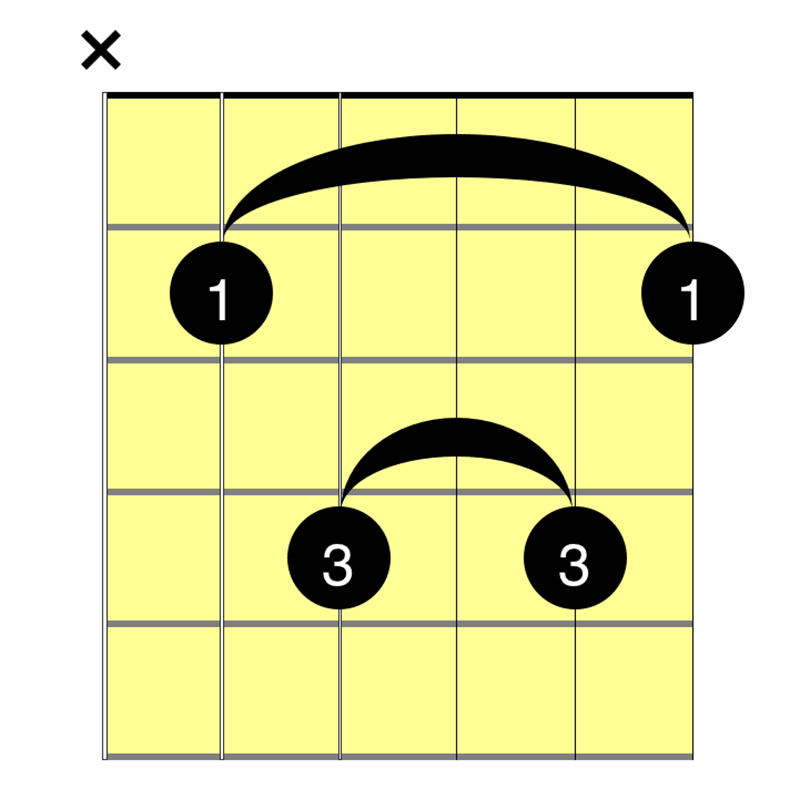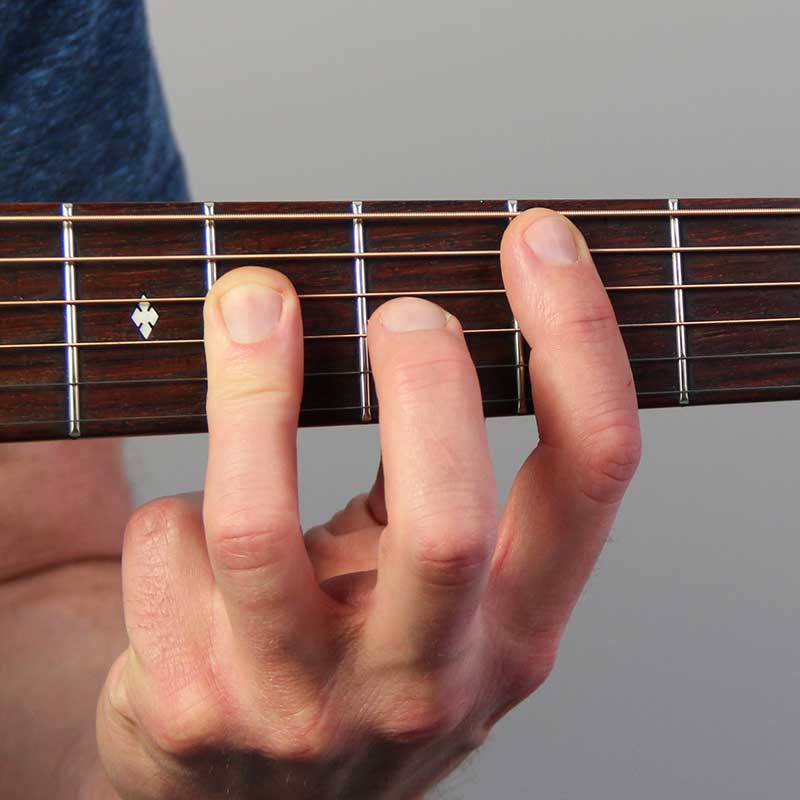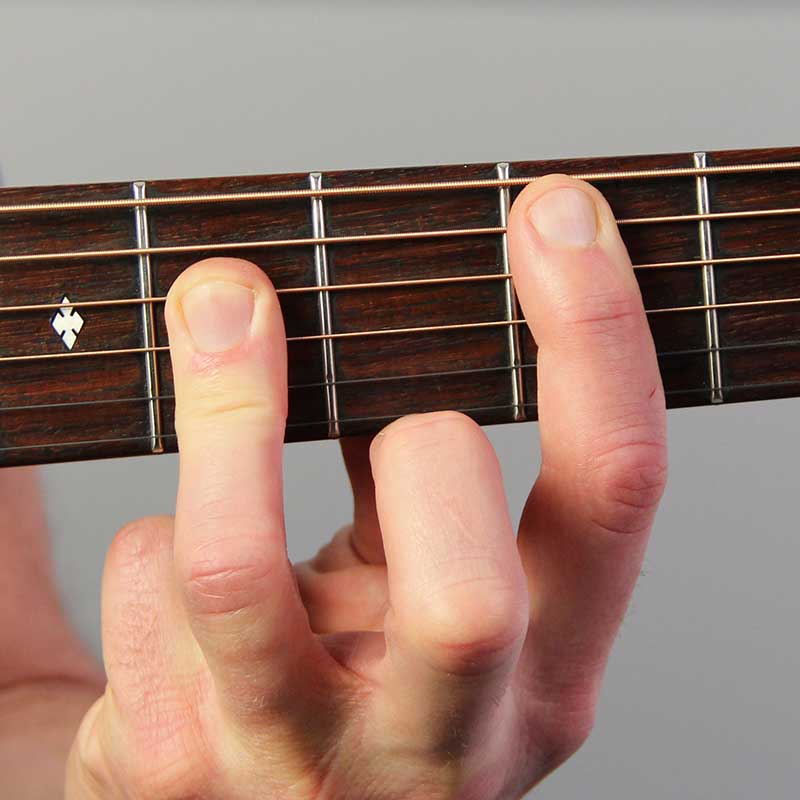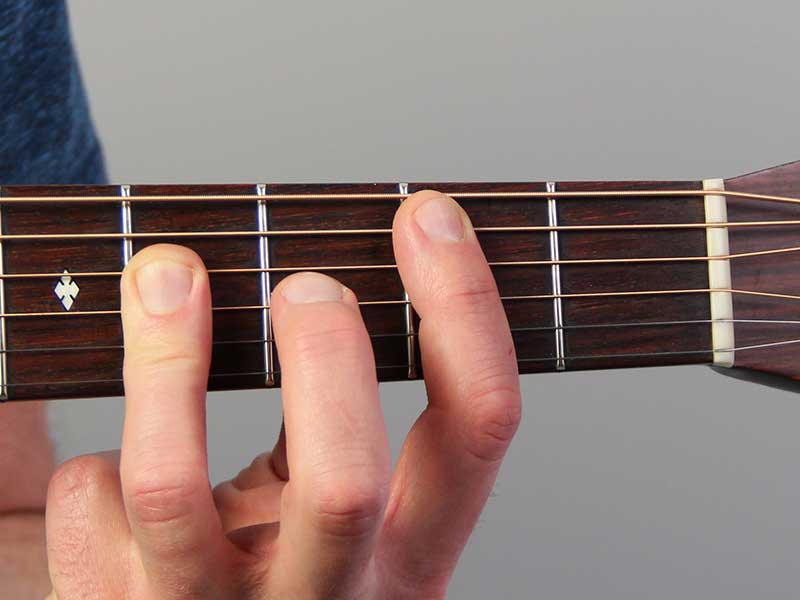The B chord (B major chord) is a tough one for beginning guitarists because, even though it’s an important and frequently used chord on the guitar, it’s relatively tricky to play. Unlike most of the basic chords a beginning guitarist needs to know, the B major chord doesn’t really have an open-string version. In other words, you need to play a barre chord, which can be hard to play if you’re not used to it. But have no fear: with a little practice, you’ll conquer it soon enough. So let’s look at how this thing is played.
Fingering the B Major Chord
To play this chord, you actually have to play two barres at the same time. (As if one barre isn’t hard enough!) First, you flatten out your third finger so that it presses down on the 2nd, 3rd, and 4th strings on the 4th fret. That’s the first barre. Then you flatten out your first finger and play strings 1 through 5 on the 2nd fret. Study the diagram and photo if you’re unclear about what I’m saying here.
I’m not gonna lie: this is hard for a beginner. There’s no getting around it. But mastering this will be so worth it because it will open up a ton of new chords to you (see below).
Note that in the photo above, it kind of looks like the middle finger is playing a note also. But it’s not; it’s just hovering above the strings. That’s just where it winds up when you put your other fingers in position. This photo on the right shows clearly that you only use two fingers (the 1st and 3rd) to play this chord. But this is just for illustration; when you actually play the chord, you won’t drop your middle finger below the fretboard like this. Your hand will look more like the picture above.
Making it Sound Good
The purpose of the first finger barre is to play two notes: the 2nd fret on the 5th string and the 2nd fret on the 1st string. It’s this note on the 1st string that is the hardest to get right, because your third finger is going to want to get in the way of that string. Getting that third finger to play three notes on the 4th fret while not getting in the way of the 1st string is probably the hardest thing about this chord.
To position the third finger correctly, you’ll have to experiment a little. Only the last joint of that finger will be playing the bar, and the rest of the finger will be angled up away from the fretboard. If it’s not angled enough, it’ll hit the E string, muting it or making it buzz. Trial and error is key to finding the right position.
“A-Shape” Barre Chords
Being able to play the B major chord is important because it’s the first “A-shape” barre chord that most people learn. Once you can play this chord, you can then easily play any other major chord because the chord shape is moveable. Want to play C major? Move the whole chord up to the 3rd fret. Want to play C# major? Move it up to the 4th fret. And so on.
In the photos below, you can see how this chord shape is derived from an open A chord. First, you re-finger the A chord so that you’re playing all the notes on the 2nd fret with your third finger. Then you slide that third finger up to the 4th fret. And finally, since you slid those notes up, you have to move those open strings up as well. You do that by making a barre with your first finger. In this chord shape, your first finger is basically acting like a moveable nut so that you can play the same shape on any fret. You can read more about this in the lesson on barre chords.
Practice
As I mentioned above, the B major chord will probably take more practice than most other beginner chords before you can get it to sound good. But it’s important to get it down because you’ll get so many other chords for free once you nail it. As always with a new chord, play each note individually to make sure they’re all sounding out nice and clear. If you hear buzzing or if a note is muted, check to see if another finger is getting in the way. Also make sure you’re pressing down hard enough.
Finally, barre chords can really make the left hand tired, even for experienced players. So don’t go overboard when you practice this chord. Keep your practice sessions short but frequent and allow your hand to rest between attempts. A sore, aching hand is no fun and is not going to help you get results any faster.







I am sure there is a better way on how to play Bchords as totally very hard to play but is there another easy chords apart from you trying to press hard on 4 strings for bchords?????
Hi Kahoa. It’s a hard chord to play, no matter how you look at it. But if you practice a little every day, it gets easier. Also, if you skip to 4:55 in the video, you can see another way to play the chord that doesn’t involve playing a barre with your 3rd finger. You can try that out to see if it works better for you. Good luck!
I am just starting to get essential chords down and try to learn different songs and that B chord is hard but G was hard for me at first I won’t give up.
Yeah, don’t give up–it will definitely come. It just takes a long time with this chord in particular. Remember that it doesn’t have to be perfect to be useful. For lots of songs that use this chord, the most important thing is that you play the first 2 or 3 notes (the B, F#, and B on the A, D, and G strings). If you don’t hear the D# on the 2nd string, it’s not the end of the world, and the F# on the high E string is even less critical. As you continue to practice the chord, your hand will get more used to it and you’ll be able to play the whole thing correctly.
The key thing with practicing a chord like this is practicing a little bit every day–even 5 minutes or less will make a huge difference. Just make sure that when you’re actually practicing (as opposed to just playing songs or whatever), you do try to use correct technique as shown in this article. You don’t want to half-ass the chord every time you play it because then you’ll just teach yourself bad technique.
Thanks John I practice at least 4 hours a day I have the essential chords down pretty good I only been playing for 5 months now at first the F chord was hard but I didn’t give up I really love playing music it’s the greatest high I ever had If that makes sense. I will keep working on that B chord.
Wow–4 hours a day is amazing! You will make very fast progress if you keep that up. And I know exactly what you mean about playing music being the greatest high ever. 🙂 Best of luck with everything!